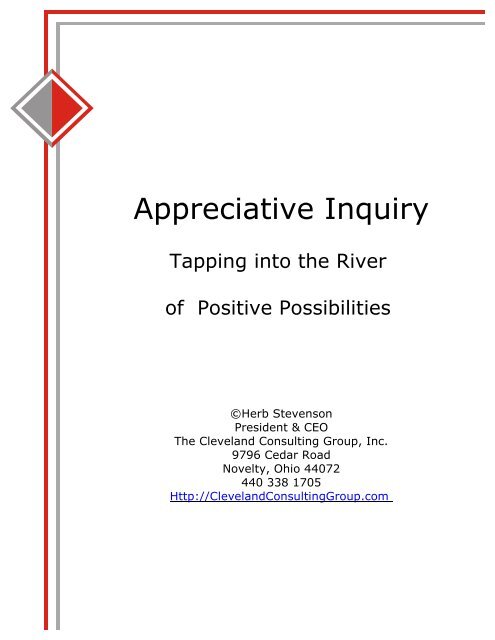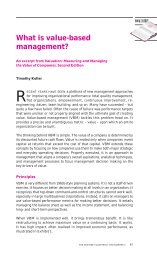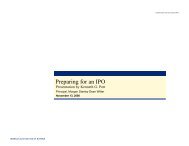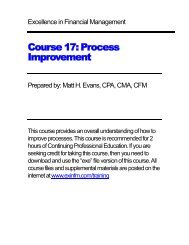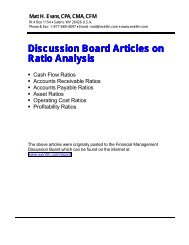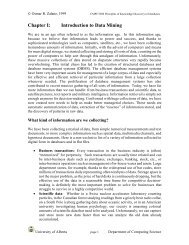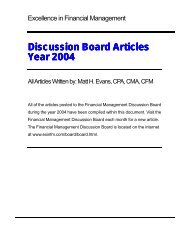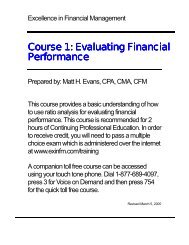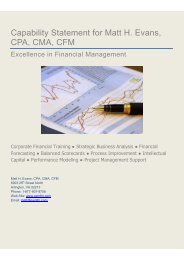Download PDF - Appreciative Inquiry - Cleveland Consulting Group
Download PDF - Appreciative Inquiry - Cleveland Consulting Group
Download PDF - Appreciative Inquiry - Cleveland Consulting Group
Create successful ePaper yourself
Turn your PDF publications into a flip-book with our unique Google optimized e-Paper software.
<strong>Appreciative</strong> <strong>Inquiry</strong><br />
Tapping into the River<br />
of Positive Possibilities<br />
©Herb Stevenson<br />
President & CEO<br />
The <strong>Cleveland</strong> <strong>Consulting</strong> <strong>Group</strong>, Inc.<br />
9796 Cedar Road<br />
Novelty, Ohio 44072<br />
440 338 1705<br />
Http://<strong>Cleveland</strong><strong>Consulting</strong><strong>Group</strong>.com
Background<br />
David Cooperrider realized that most organizations are predisposed towards<br />
“what is wrong” within the organization. He attributed this predisposition to the<br />
inculcated problem-solving mentality of the scientific method which tends to<br />
ignore “what is working”, “has gone well”, and “does not need fixed”<br />
components of the organization. In developing <strong>Appreciative</strong> <strong>Inquiry</strong>,<br />
Cooperrider refocused the attention away from the critical, more pessimistic<br />
perceptions of the organization to the supportive, more optimistic behaviors. In<br />
doing so, he sought to harness the untapped creative energies by redirecting<br />
the attention away from object relations problem solving and towards an<br />
appreciative inquiry of the stories of success held by the people within the<br />
organization. Therein, a sense of community is created as commonality, pride,<br />
and creativity are unleashed. The end result is a new perspective of the<br />
organization and of what is possible. (Cooperrider & Dutton, 1999; Cooperrider<br />
& Whitney, 1999; Cooperrider et. al. 2000)<br />
Critical Premise<br />
A critical premise within the <strong>Appreciative</strong> <strong>Inquiry</strong> method is that we are<br />
constantly creating our perceived reality. Some of this creating of perceptions is<br />
influenced by what we believe, which becomes an unchecked and rarely cleaned<br />
filter of what we can see. For example, if an organization has a core belief that<br />
revolves around being the best or the fastest or biggest, this belief implies that<br />
the firm must constantly find a way to improve. From a management<br />
perspective, this seems like a worthy goal. However, from an employee<br />
perspective, it also means that whatever work is completed is never “good<br />
enough”. Hence, the core belief that the firm must constantly improve connotes<br />
to all within the firm, that no matter what is accomplished, or how well the firm<br />
performs, there is something inadequate, incomplete, and/or not good enough<br />
about the organization and each individual within.<br />
Cooperrider referred to this behavior as deficit thinking based on the problemsolving<br />
predisposition of most organizations. More importantly, by paying<br />
attention to what is wrong, inadequate, or not good enough, we emphasize and<br />
amplify them by creating a language of deficit that permeates our thoughts and<br />
our words.<br />
It is at this juncture that many CEOs feel like pulling their hair. Focused on the<br />
problem solving aspect of deficit thinking, the organization begins to resist<br />
every attempt to improve performance or to follow corrective action policies.<br />
Management has one perception and the employees have another of what it<br />
means to solve problems. Management views problem solving in the form of<br />
growth expectations, service quality, and efficiency as the core of good<br />
business. Employees view problem solving as a never ending process of<br />
frustration that negates all humanness within the organization. Hence, not only<br />
©Herb Stevenson 2 <strong>Appreciative</strong> <strong>Inquiry</strong><br />
http://<strong>Cleveland</strong><strong>Consulting</strong><strong>Group</strong>.com
does the organization see what it believes, but the very act of believing it<br />
creates it. (Bushe, 1995)<br />
The organization becomes enmeshed in isolated and incompatible perceptions.<br />
Neither side tends to be able to see the other’s perceptions because it does not<br />
fit into each groups believed and therefore perceived reality. Unless the<br />
collective has experienced a clear and believable bridge between the two<br />
perceptions, any talk about the situation becomes another exercise in affirming<br />
the existing beliefs.<br />
Comparison of Two Views<br />
Problem Solving<br />
"Felt need"<br />
Identification of Problem<br />
Analysis of Causes<br />
Analysis of possible solutions<br />
Action planning<br />
(Treatment)<br />
<strong>Appreciative</strong> <strong>Inquiry</strong><br />
Appreciating and valuing<br />
the best of "what is"<br />
Envisioning "what might be"<br />
Dialoguing "What should be"<br />
Innovating "What will be"<br />
Basic Assumption: An<br />
organization is a problem to be<br />
solved.<br />
Basic Assumption: An<br />
organization is a mystery<br />
to be embraced.<br />
Adapted from Cooperrider and Srivasta (1987) "<strong>Appreciative</strong> <strong>Inquiry</strong> into Organizational Life" in<br />
Pasmore and Woodman (Eds.). Research in Organizational Change and Development. Vol. 1 JAI<br />
Press.<br />
<strong>Appreciative</strong> <strong>Inquiry</strong><br />
The basic premise of <strong>Appreciative</strong> <strong>Inquiry</strong> could be applied to how an<br />
organization views a glass of water. If it is viewed as half empty, the<br />
organization would probably be oriented towards problem solving and deficit<br />
thinking---how do we fill the glass to the brim or how do we catch the culprit<br />
drinking our water. If the glass is viewed as half full, the organization would<br />
probably be positively oriented towards "what works" and on enjoying the small<br />
and/or individual successes of each day.<br />
<strong>Appreciative</strong> inquiry searches for "what works" through the innumerable<br />
individual success stories within the organization that are embedded with<br />
excitement, creativity, and pride. Once discovered, these stories are shared<br />
throughout the organization. Individuals are recognized and affirmed as<br />
contributing and successful members of the organization. Confidence and<br />
commitment to more success begin to permeate the individual and<br />
organizational belief systems. What is "wrong", "inadequate" and/or "not good<br />
©Herb Stevenson 3 <strong>Appreciative</strong> <strong>Inquiry</strong><br />
http://<strong>Cleveland</strong><strong>Consulting</strong><strong>Group</strong>.com
enough" moves out of awareness as the organization taps into the river of<br />
positive possibilities. It becomes clear that the future can be built on the<br />
successes of the past.<br />
Assumptions of <strong>Appreciative</strong> <strong>Inquiry</strong><br />
1. In every society, organization, or group, something works.<br />
2. What we focus on becomes our reality.<br />
3. Reality is created in the moment, and there are multiple realities.<br />
4. The act of asking questions of an organization or groups influences the<br />
group in some way.<br />
5. People have more confidence and comfort to journey to the future (the<br />
unknown) when they carry forward parts of the past (the known).<br />
6. If we carry parts of the past forward, they should be what is best about<br />
the past.<br />
7. It is important to value differences.<br />
8. The language we use creates our reality.<br />
Adapted from Sue Annis Hammond, (1998) 2nd Edition. The Thin Book of <strong>Appreciative</strong> <strong>Inquiry</strong><br />
Plano, Texas: Thin Book Publishing Company, 20-21.<br />
An Important Diversion<br />
<strong>Appreciative</strong> inquiry relies on two important discoveries. First, Carl Jung came to<br />
the conclusion that most important problems are rarely solved. Rather, they are<br />
outgrown as interest shifts to something new or more intriguing, thereby<br />
leaving the original problem to fade away. Second, brain research has<br />
discovered that the human brain does not register or hear the word "not".<br />
Rather, to alter human behavior, it is more effective to positively tell the person<br />
what is expected instead of telling him or her what is not wanted. Returning to<br />
appreciative inquiry, as the individual and organization reveal "what works"<br />
within the organization, it is shifting the focus away from problem solving and<br />
©Herb Stevenson 4 <strong>Appreciative</strong> <strong>Inquiry</strong><br />
http://<strong>Cleveland</strong><strong>Consulting</strong><strong>Group</strong>.com
things employees are not to do and towards positive examples of what is<br />
successful within the organization.<br />
Pollyanna<br />
Much of the criticism towards appreciative inquiry relates to a disbelief in using<br />
a positive frame of reference instead of a problem solving focus. It is often<br />
framed as being a Pollyanna, where the individual is accused of wearing rose<br />
colored glasses and only seeing the good, the pleasant, the positive things in life<br />
to the exception of the real business at hand.<br />
<strong>Appreciative</strong> inquiry does not negate nor ignore problems. Rather, it shifts the<br />
lens and/or frame of reference that is used to define what is happening. Instead<br />
of looking for “what’s wrong” or “needs fixed” the firm focuses on “what’s right”<br />
or “what’s working” and seeks to do more of it. In short, appreciative inquiry<br />
suggests that you can create change by paying attention to what you want<br />
rather than paying attention to problems. (Bushe, 2000, 99)<br />
For example, after experiencing an appreciative inquiry, the organization tends<br />
to develop more trust between individuals. This trust leads to soliciting support<br />
to find a successful response to a situation. Responses to such requests tend to<br />
be framed in ways that other employees have successfully addressed similar<br />
situations. Combined, appreciative inquiry tends to move away from identifying<br />
all situations as problems and therefore from hiding problems from others so<br />
that the person does not look incompetent. Instead, the frame of reference is<br />
towards trusting what has worked in the past and the revealing of situations to<br />
determine if others may have experienced the situation and how they<br />
successfully addressed it.<br />
Collective Vision<br />
Building on the idea that “we see what we believe”, appreciative inquiry seeks to<br />
change the belief building and reinforcing frame of reference. Instead of<br />
insufficiency, inadequacy, and incompetency, the focus moves toward wholeness,<br />
completeness, and skillfulness. As such, appreciative inquiry seeks to surface<br />
existing individual and collective images of what each individual and the entire<br />
organization has been and can be at its very best.<br />
The <strong>Appreciative</strong> Process<br />
<strong>Appreciative</strong> inquiry involves five phases: (1) Affirmative Topic Choice, (2)<br />
Discovery—Appreciating, (3) Dream—Envisioning Results, (4) Design—Coconstructing,<br />
and (5) Destiny—Sustaining.<br />
©Herb Stevenson 5 <strong>Appreciative</strong> <strong>Inquiry</strong><br />
http://<strong>Cleveland</strong><strong>Consulting</strong><strong>Group</strong>.com
Figure 1. Phases of <strong>Appreciative</strong> <strong>Inquiry</strong><br />
Discovery<br />
What Gives Life<br />
Appreciating—the<br />
best of “what is”<br />
Destiny Affirmative Dream<br />
“How to empower, Topic What might be<br />
learn, adjust, and Choice Envisioning Results<br />
improvise<br />
Sustaining<br />
Design<br />
What should be—<br />
the ideal<br />
Co-constructing<br />
Although, the five phases are often portrayed as a circle, with a circular<br />
movement that suggests a linearity to the process, I prefer to refer to it as a<br />
wheel where the actual process is not around the outside circle, but a constant<br />
motion of moving from the center of the circle outward to the applicable phase<br />
and back to the center. This alternative perspective enables the complexity of the<br />
process to more clearly unfold. <strong>Appreciative</strong> inquiry is an exploration of an<br />
affirmative topic that has been chosen for study. This study entails moving into<br />
and through four phases, constantly returning to the original topic within the<br />
center. Keeping the affirmative topics chosen at the center or core of the process<br />
ensures the deepening process that is sought.<br />
©Herb Stevenson 6 <strong>Appreciative</strong> <strong>Inquiry</strong><br />
http://<strong>Cleveland</strong><strong>Consulting</strong><strong>Group</strong>.com
Affirmative Topic Choice<br />
Topic selection begins the adventure into appreciative inquiry. It requires<br />
searching for the positive description of what is desired by the organization.<br />
Because individually and collectively we move towards whatever we study, the<br />
selection of the AI topics is critical. It is the foundation of the entire process.<br />
Hence, the topic choice process should be an affirmative act —<br />
• that will lead to what gives life to the organization,<br />
• that represents what the organization wants to discover or learn more<br />
about,<br />
• that evokes conversations of the desired future, and/or<br />
• that reveals more about what they want to see grow and flourish in their<br />
organization.<br />
In a nutshell, the topics should be bold—something that stretches the<br />
organization beyond the status quo, desired—something that you really want to<br />
see happen, and stimulating—something that has the potential to energize<br />
people, mobilize forces, and be strategic.<br />
Preparing for Topic Selection<br />
The selection of the AI topics can be supported through an exercise. As an initial<br />
exploration, each member of the AI team or summit will complete the following<br />
exercise by recording their responses on a piece of paper —<br />
• Describe a peak experience or “high point”<br />
• What things do you value most about —<br />
» yourself<br />
» the nature of your work<br />
» the organization<br />
• What do you consider to be the core factor that gives “life” to the<br />
organization<br />
• What three wishes would you make to heighten vitality and health in this<br />
organization<br />
Once each person has completed the exercise, the AI team divides itself into<br />
©Herb Stevenson 7 <strong>Appreciative</strong> <strong>Inquiry</strong><br />
http://<strong>Cleveland</strong><strong>Consulting</strong><strong>Group</strong>.com
pairs. Each person takes a turn at interviewing and being interviewed. The<br />
questions just answered are used with the interviewer probing deeper into the<br />
answers, getting excited, being surprised, curiously inquiring. Listen intently.<br />
Pause before asking questions.<br />
Each pair joins to form a group of 8-12 people. The interviewers report to the<br />
group what was learned from the interview. A list is created on newsprint/poster<br />
boards.<br />
Three to five themes are developed from the lists. Using themes listed on the<br />
newsprint, develop topics that can be affirmatively explored. Consider the<br />
following ways to create an affirmative topic—<br />
• reversing a problem into a positive statement, customer complaints to<br />
customer compliments.<br />
• using improbable word pairings to deepen the meaning such as congruent<br />
commitment, honest authenticity, radically clear communications, optimal<br />
integrity, meaning-making relationship, organizational optimism, and/or<br />
lightning fast consensus.<br />
Once the topics are selected (three to five), we move into the discovery phase.<br />
Discovery—What gives life (the best of What is)—Appreciating<br />
The discovery phase involves a data collection and narrative exploration. It begins<br />
the process of revealing the positive, the successful, and the prideful experiences<br />
of the individual and collective. Through carefully developed interview questions<br />
based in the affirmative topic selection, the focus is to explore and enliven the<br />
stories that are shared through interviewing the defined group within the<br />
organization. Generally, the more reflective of the entire organization, the more<br />
effective the outcome.<br />
The steps in the discovery phase are as follows:<br />
• Identify stakeholders.<br />
• Decide who will be interviewed.<br />
• Develop interview protocol/questionnaire and distribute to team members.<br />
• Decide on a method/format for organizing the data<br />
» How will findings be recorded<br />
» How will the team’s data be compiled<br />
» Who will do it<br />
©Herb Stevenson 8 <strong>Appreciative</strong> <strong>Inquiry</strong><br />
http://<strong>Cleveland</strong><strong>Consulting</strong><strong>Group</strong>.com
• Conduct the interviews<br />
• Create a method for capturing the best stories, data, and visions.<br />
The intent is to energize both the interviewers and interviewees as they share<br />
their experiences and history with the organization, as well as their values and<br />
wishes for the future. Noteworthy is that this is a mutual learning process for the<br />
interviewer and interviewee. Within this learning process, the frame of reference<br />
of the organization begins to shift from problem solving and/or deficit thinking to<br />
possibility evolving and successfully working.<br />
Interview Protocol<br />
The interview protocol begins the process of changing the frame of reference of<br />
the individual and the collective. As Cooperrider and Whitney note, we need to<br />
remember throughout this process that<br />
What we ask determines what we find.<br />
What we find determines how we talk.<br />
How we talk determines how we imagine together.<br />
How we imagine together determines what we achieve.<br />
The interview protocol includes three parts: (1) Developing Stage Setting<br />
Questions, such as what do you value most about yourself, your work, and your<br />
organization (2) Establishing the topic or subject matter surrounding the<br />
appreciative inquiry and developing questions with lead-ins, and (3) Developing a<br />
closing questions that conclude the interview and begins to open the sense of<br />
possibility, such as—<br />
• What are the core factors that give life to this organization<br />
• Looking toward the future, what are we being called to become<br />
• What three wishes do you have for changing the organization<br />
Interview Summary<br />
Each interview needs to be recorded so that a determination of themes can be<br />
completed and that the stories can be shared in such a way as to build<br />
community awareness and pride as well as ensure individual confidentiality.<br />
Typically, an interview summary sheet is developed that includes some variation<br />
of the following:<br />
• Name of the interview and the date of the interview<br />
• What was the most quotable/best quote that came out of this interview<br />
©Herb Stevenson 9 <strong>Appreciative</strong> <strong>Inquiry</strong><br />
http://<strong>Cleveland</strong><strong>Consulting</strong><strong>Group</strong>.com
• What was the most compelling story that came out of this interview<br />
• List 1-3 themes that stood out for you during the interview.<br />
Dreaming—What might be—Envisioning Results<br />
The dream phase of appreciative inquiry begins the process of what could be.<br />
Whether we call it dreaming, envisioning, or imagining, the focus is to think about<br />
possibilities beyond the realm of present day thinking. It is a brief window of<br />
opportunity. The collective interviews have built a cache of stories of successful<br />
ways of being within the organization. If these stories are grounded into the<br />
organization’s psyche, they will become the foundation for building the<br />
organization’s future. In short, the frame of reference will begin to shift through<br />
the stories that have been told.<br />
Dream Practice<br />
The dreaming process involves forming small groups of 8-12 people. These<br />
groups review the summary sheets from the interviews. The focus is to build<br />
common ground within the group based on the success stories and questions<br />
based on dreams, hopes, and visions of the future of the organization from the<br />
original interviews.<br />
The groups then discuss their individual visions of the ideal organization and<br />
describe what would be happening 5-25 years into the future. From this<br />
discussion, the group’s collective vision is developed. (If desired, facilitators can<br />
direct the process based on themes of the future that have surfaced from the<br />
interview process.) Typically, the dream or strategic focus becomes articulated as<br />
a vison of a better organizational world, a powerful purpose, and a compelling<br />
statement of strategic intent. (Cooperrider & Whitney)<br />
Each group is encouraged to step out of the box or to bring more of whom they<br />
are into the room by preparing an expressive enactment of their group dream of,<br />
hope for,or vision of the organization. This enactment can be Parodies or Poetry,<br />
TV or Radio commercials, Jingles or Songs, One Act Plays or Mime, Play by Play<br />
descriptions or Instant replays, etc. The expressions of these dreams are<br />
presented to the other groups.( As a side note, this process tends to open the<br />
door of playfulness which leads to creative expressions.)<br />
Possibilities<br />
The outcomes from this process will be the surfacing of common ground between<br />
the groups. This common ground creates a collective awareness that more than<br />
“just me” has a specific dream about the organization. Therein, the dream moves<br />
towards the next step of being manifested into reality.<br />
©Herb Stevenson 10 <strong>Appreciative</strong> <strong>Inquiry</strong><br />
http://<strong>Cleveland</strong><strong>Consulting</strong><strong>Group</strong>.com
Design—What should be - the ideal—Co-constructing<br />
The design phase begins to build the bridge from the best of “what is” (present)<br />
within the organization towards a speculative or intuitive “what might be”<br />
(future). Provocative propositions are developed as bold statements of the<br />
organization of the future as if it has already happened. Using the themes and<br />
dreams that have evolved from the prior three phases, the design phase seeks to<br />
create the social architecture to materialize the desired, ideal organization.<br />
Questions such as what would we (our organization) look like if it were designed<br />
in every way to maximize and preserve the topics that were chosen for study.<br />
Returning to groups of 8-12, the focus of developing provocative propositions is<br />
threefold:<br />
(1) From the interviews in the discovery phase and the future images from the<br />
dream phase, find examples of the best, the ideal, the desired.<br />
(2) Reflect and dialogue on what circumstances made the best, the ideal, the<br />
desired possible. Record these circumstances in detail.<br />
(3) Take the stories and envision what might be. Write an affirmative<br />
statement that describes the idealized future as if it has already happened.<br />
To ensure comprehensiveness, the design of the social architecture might include<br />
such organizational components as—leadership, strategy, culture, societal<br />
purposes, shared values, management and business practices, ethics and social<br />
responsibility, competencies, stakeholder relations, structures and systems,<br />
desired results in financial or diversity or other areas.<br />
Destiny—how to empower, learn, adjust, improvise—Sustaining<br />
The final phase of appreciative inquiry is destiny. <strong>Appreciative</strong> inquiry generates a<br />
repatterning of our relationships with our self, others, and how we perceive the<br />
world. Our ways of knowing the world changes from the socially and culturally<br />
contrived to the personally and professionally chosen. We know that we create<br />
the organizations in which we live. To encourage this process, the appreciative<br />
inquiry process can be integrated through using an appreciative questionnaire.<br />
Typically, the following questions can support the individual process.<br />
(1) What about the appreciative inquiry process most enlivened you<br />
(2) What excites you most about introducing appreciative inquiry to your<br />
clients/organization<br />
(3) What appreciative inquiry competencies have you discovered within<br />
yourself<br />
©Herb Stevenson 11 <strong>Appreciative</strong> <strong>Inquiry</strong><br />
http://<strong>Cleveland</strong><strong>Consulting</strong><strong>Group</strong>.com
(4) What’s your favorite story about appreciative inquiry<br />
(5) What visions do you have for taking this process to a new level within your<br />
organization<br />
At an organizational level, the destiny phase suggests that if the appreciative<br />
inquiry process of positive transformation is supported through empowering<br />
employees to connect, cooperate and co-create, the results will continue to<br />
surface in new, innovate, and bold ways.<br />
Application<br />
The actual process can be adapted to almost any situation. For example, it can be<br />
used for strategic planning, diversity management, or any other critical issue<br />
related to the functioning of the organization.<br />
For example, the strategic planning process might include the following steps:<br />
Step 1: An Ai consultant provides a full day explaining/training the theoretical<br />
basis for the work. The Ai consultant helps the Ai team construct an Ai interview<br />
protocol.<br />
Step 2: The Ai team uses the protocol to interview all or a significant majority of<br />
stakeholders. Stakeholders typically include all or a significant number of people<br />
in the organization as well as people with a vested interest, such as family,<br />
suppliers, and/or customers.<br />
Step 3: The Ai team brings the data to three to five day retreat, where it<br />
develops a written set of possibility propositions from the collected interview data.<br />
Step 4: The Ai consultant supports the Ai team as it works to incorporate the<br />
possibility propositions into its mission and vision.<br />
Step 5: The Ai team assesses the impact the retreat has had on it and the<br />
potential impact on the organization.<br />
Ai Consultant time including Ai Training (1), Retreat (3-5), and Follow-up days (4)<br />
eight to ten days.<br />
Ai Team time, including Ai training (1), Interviews (2-5), and Retreat (3-5), is six<br />
to eleven days.<br />
©Herb Stevenson 12 <strong>Appreciative</strong> <strong>Inquiry</strong><br />
http://<strong>Cleveland</strong><strong>Consulting</strong><strong>Group</strong>.com
Roles and Responsibilities<br />
Before During After<br />
Ai Consultants<br />
Introduce Ai to the<br />
organization<br />
Focus on the<br />
“business case” for Ai<br />
Train groups in Ai<br />
Support the Core<br />
Team<br />
Facilitate the Summit<br />
Assist the<br />
organization to<br />
integrate Aim into<br />
daily practices.<br />
Ai Sponsors<br />
Become<br />
knowledgeable in Ai<br />
Plant the Ai seed<br />
Champion Ai in the<br />
organization<br />
Participate—as an<br />
equal, essential voice.<br />
Ask, how might we<br />
take an Ai approach<br />
to this<br />
Lead by affirmation<br />
Ai Core Team<br />
Become<br />
knowledgeable in Ai<br />
Select affirmative<br />
topics<br />
Use Ai as a daily<br />
practice.<br />
Create Interview<br />
protocol<br />
Determine interview<br />
strategy<br />
Communicate “best”<br />
stories<br />
Ai Interviewers<br />
Become<br />
knowledgeable in Ai<br />
Conduct interviews<br />
Summarize “Best”<br />
stories<br />
See Ai as a daily<br />
practice<br />
Ai Summit<br />
Participants<br />
Conduct interviews or<br />
be interviewed<br />
Review interview<br />
report<br />
Engagwe in discovery<br />
and dialogue<br />
Date to dream<br />
Design the ideal<br />
organization<br />
Sustain Ai<br />
organizational<br />
processes and<br />
practices<br />
Create new systems<br />
and structures using<br />
Ai.<br />
Share success stories.<br />
Adapted from David Cooperrider & Diana Whitney (1999) A Positive Revolution in Change:<br />
<strong>Appreciative</strong> <strong>Inquiry</strong>. in Holman, Peggy and Tom Devane (Eds.) The Change Handbook, San<br />
Francisco: Berrett-Koehler, 252-253.<br />
©Herb Stevenson 13 <strong>Appreciative</strong> <strong>Inquiry</strong><br />
http://<strong>Cleveland</strong><strong>Consulting</strong><strong>Group</strong>.com
References<br />
Bushe, Gervase, R. (1995) Advances in <strong>Appreciative</strong> <strong>Inquiry</strong> as a Organization<br />
Development Intervention. Organization Development Journal, Vol. 13, No. 3. 14-<br />
22.<br />
Bushe, Gervase R. (2000) Five Theories of change Embedded in <strong>Appreciative</strong><br />
<strong>Inquiry</strong>. in Cooperrider, David, Sorensen, Peter F., Whitney, Diana, Yaeger,<br />
Therese F. (Eds.) (2000) <strong>Appreciative</strong> <strong>Inquiry</strong>. Champaign, Illinois: Stipes<br />
Publishing. 99-109.<br />
Cooperrider, David, L. & Whitney, Diana, (1999) <strong>Appreciative</strong> <strong>Inquiry</strong>. San<br />
Francisco: Berrettt-Koehler.<br />
Cooperrider, David, L. & Whitney, Diana, (2000) A Positive Revolution in Change:<br />
<strong>Appreciative</strong> <strong>Inquiry</strong>. in Cooperrider, David, Sorensen, Peter F., Whitney, Diana,<br />
Yaeger, Therese F. (Eds.) <strong>Appreciative</strong> <strong>Inquiry</strong>. Champaign, Illinois: Stipes<br />
Publishing. 3-27.<br />
Cooperrider, David, L. & Whitney, Diana, (1999) A Positive Revolution in Change:<br />
<strong>Appreciative</strong> <strong>Inquiry</strong>. in Holman, Peggy and Tom Devane (Eds.) The Change<br />
Handbook, San Francisco: Berrett-Koehler, 245-262<br />
Cooperrider, David and Dutton, Jane E. (Eds.) (1999) Organizational Dimensions<br />
of Global Change: No Limits to Cooperation. Thousand Oaks, Ca.: Sage.<br />
Cooperrider, David, Sorensen, Peter F., Whitney, Diana, Yaeger, Therese F. (Eds.)<br />
(2000) <strong>Appreciative</strong> <strong>Inquiry</strong>. Champaign, Illinois: Stipes Publishing.<br />
Hammond, Sue Annis, (1998) The Thin Book of <strong>Appreciative</strong> <strong>Inquiry</strong>. 2 Ed.<br />
nd<br />
Plano, Texas: Thin Book Publishing Co.<br />
©Herb Stevenson 14 <strong>Appreciative</strong> <strong>Inquiry</strong><br />
http://<strong>Cleveland</strong><strong>Consulting</strong><strong>Group</strong>.com


